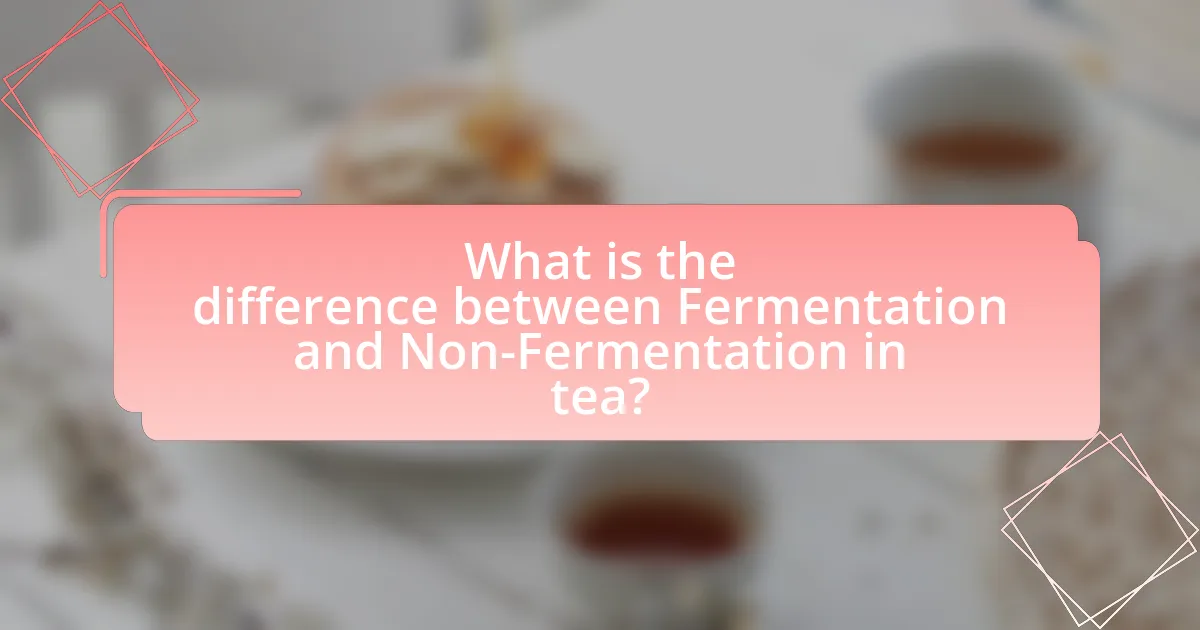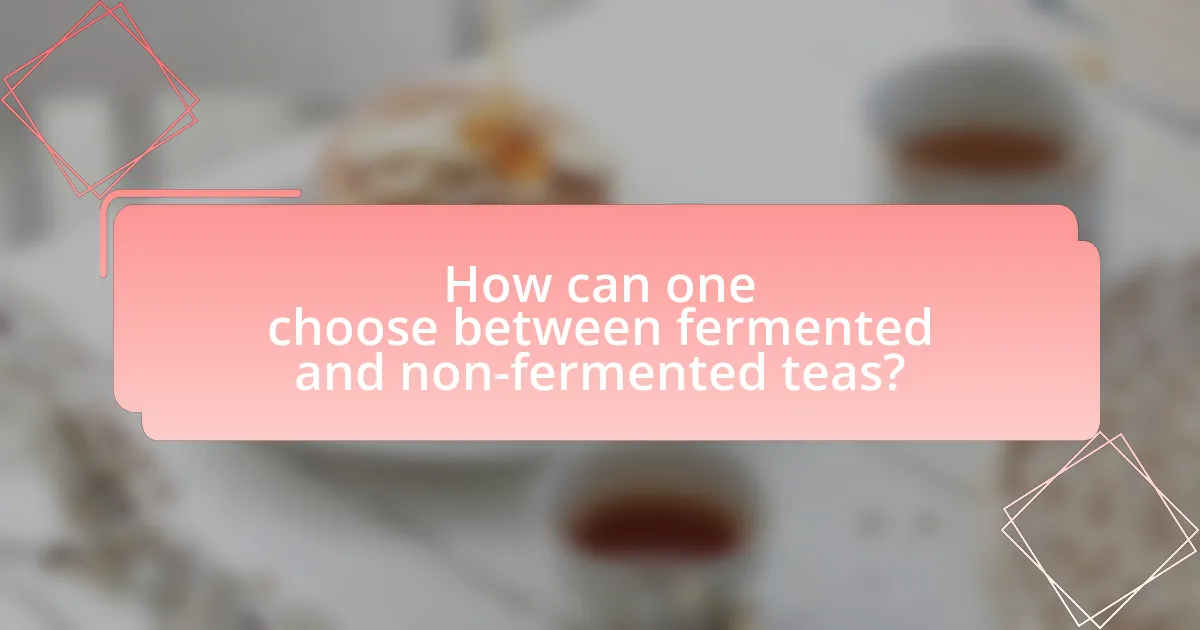The article explores the differences between fermented and non-fermented teas, focusing on how fermentation affects flavor, aroma, and health benefits. It details the biochemical processes involved in fermentation, including oxidation and enzymatic reactions, and highlights various types of fermented teas such as black tea, pu-erh, and kombucha, alongside non-fermented varieties like green and white tea. Additionally, the article discusses the cultural implications of tea fermentation, brewing techniques, and factors influencing tea selection, providing a comprehensive understanding of how fermentation shapes the characteristics and health properties of different tea types.

What is the difference between Fermentation and Non-Fermentation in tea?
Fermentation in tea refers to the biochemical process where tea leaves undergo oxidation, leading to changes in flavor, color, and aroma, primarily seen in black tea. Non-fermentation, on the other hand, involves minimal oxidation, preserving the green color and fresh taste of the leaves, characteristic of green tea. The distinction is crucial as fermentation results in a richer, darker brew, while non-fermentation maintains a lighter, more vegetal profile.
How does fermentation affect the flavor and characteristics of tea?
Fermentation significantly alters the flavor and characteristics of tea by introducing complex chemical reactions that enhance its taste profile. During fermentation, enzymes break down catechins into theaflavins and thearubigins, which contribute to the rich, malty flavors found in black tea. This process also affects the aroma, resulting in a more robust and varied scent compared to non-fermented teas. Additionally, fermentation can influence the color of the tea, leading to darker hues in fully fermented varieties. Studies have shown that the fermentation process can increase the antioxidant properties of tea, further enhancing its health benefits while simultaneously modifying its sensory attributes.
What chemical processes occur during the fermentation of tea?
The chemical processes that occur during the fermentation of tea primarily include oxidation and enzymatic reactions. During fermentation, polyphenols in tea leaves oxidize, leading to the formation of complex compounds such as theaflavins and thearubigins, which contribute to the flavor, color, and aroma of the tea. This oxidation process is facilitated by enzymes like polyphenol oxidase, which catalyze the conversion of catechins into these new compounds. The extent of oxidation determines the type of tea produced, with fully fermented teas like black tea exhibiting a darker color and richer flavor profile compared to less fermented varieties.
How does fermentation influence the health benefits of tea?
Fermentation enhances the health benefits of tea by increasing the bioavailability of antioxidants and promoting the growth of beneficial probiotics. During fermentation, compounds such as catechins are transformed into more complex polyphenols, which have been shown to improve cardiovascular health and reduce inflammation. Additionally, fermented teas like kombucha contain probiotics that support gut health, as evidenced by studies indicating that these microorganisms can improve digestion and boost the immune system. Thus, fermentation not only alters the chemical composition of tea but also amplifies its potential health benefits.
What types of fermented teas are there?
There are several types of fermented teas, primarily including black tea, pu-erh tea, and kombucha. Black tea undergoes full oxidation, which is a form of fermentation, resulting in its dark color and robust flavor. Pu-erh tea is a unique fermented tea that undergoes a specific microbial fermentation process, often aged for years, which enhances its earthy taste and health benefits. Kombucha is a fermented beverage made from sweetened tea and a symbiotic culture of bacteria and yeast (SCOBY), known for its probiotic properties. Each of these fermented teas has distinct characteristics and health benefits, supported by their unique fermentation processes.
What are the characteristics of black tea as a fermented type?
Black tea is characterized as a fully fermented type of tea, undergoing a complete oxidation process that transforms its leaves into a dark color and rich flavor profile. This fermentation process involves withering, rolling, oxidizing, and drying the tea leaves, which enhances the tea’s caffeine content and produces a robust taste with malty, fruity, or floral notes. The oxidation level of black tea typically ranges from 90% to 100%, distinguishing it from other tea types like green or oolong tea, which are only partially fermented. The high oxidation also contributes to the presence of polyphenols, which are linked to various health benefits, including antioxidant properties.
How does oolong tea differ from other fermented teas?
Oolong tea differs from other fermented teas primarily in its partial oxidation process, which ranges between 10% to 80%, unlike fully fermented black tea or minimally fermented green tea. This unique oxidation level results in a flavor profile that is more complex and varied than that of other fermented teas, offering floral, fruity, and creamy notes. Additionally, oolong tea is often produced through a specific method that includes withering, rolling, and a controlled oxidation process, which is distinct from the methods used for other fermented teas like black tea, which undergoes complete oxidation.
What are the characteristics of non-fermented teas?
Non-fermented teas, also known as unoxidized teas, are characterized by their minimal processing, which preserves the natural green color and fresh flavor of the tea leaves. These teas, such as green tea and white tea, retain high levels of antioxidants, particularly catechins, due to the lack of fermentation. The absence of fermentation results in a lighter taste profile, often described as grassy or vegetal, and a higher concentration of beneficial compounds compared to fermented varieties. For instance, studies have shown that green tea contains significantly more catechins than black tea, which undergoes full fermentation.
What types of non-fermented teas exist?
Non-fermented teas primarily include green tea, white tea, and yellow tea. Green tea is made from unoxidized leaves and is known for its high antioxidant content, while white tea consists of young leaves and buds, offering a delicate flavor profile. Yellow tea, a rarer type, undergoes a slight oxidation process but is still classified as non-fermented due to its minimal processing. These categories are recognized for their distinct characteristics and health benefits, supported by studies highlighting their antioxidant properties and potential health advantages.
How does the processing of green tea differ from fermented teas?
The processing of green tea involves minimal oxidation, primarily through steaming or pan-firing, which preserves its green color and fresh flavor. In contrast, fermented teas, such as black tea and pu-erh, undergo a process of oxidation where the leaves are allowed to wither and ferment, resulting in a darker color and richer flavor profile. This fundamental difference in processing techniques leads to distinct taste, aroma, and health benefits associated with each type of tea.

Why is understanding fermentation important for tea enthusiasts?
Understanding fermentation is crucial for tea enthusiasts because it directly influences the flavor, aroma, and health benefits of different tea types. Fermentation, or oxidation, alters the chemical composition of tea leaves, resulting in distinct varieties such as green, black, and oolong teas. For instance, black tea undergoes full oxidation, leading to a robust flavor profile, while green tea is minimally processed to retain its fresh taste. Knowledge of fermentation processes allows tea enthusiasts to appreciate the complexities of tea production, select teas that align with their preferences, and understand the impact of fermentation on antioxidant levels and other health-related properties.
How does fermentation impact the tea’s aroma and taste profile?
Fermentation significantly alters tea’s aroma and taste profile by enhancing complexity and depth. During fermentation, chemical reactions occur that develop unique flavor compounds, such as esters and phenols, which contribute to a richer and more nuanced taste. For example, black tea undergoes full oxidation, resulting in a bold, malty flavor and a sweet aroma, while oolong tea experiences partial fermentation, leading to floral and fruity notes. Studies have shown that the fermentation process can increase the concentration of certain volatile compounds, which are responsible for the aromatic qualities of the tea, thereby creating a distinct sensory experience.
What role does oxidation play in the fermentation process?
Oxidation plays a crucial role in the fermentation process by influencing the chemical composition and flavor profile of the final product. During fermentation, oxidation occurs when compounds in the tea leaves react with oxygen, leading to the development of complex flavors and aromas. For example, in the production of black tea, oxidation transforms catechins into theaflavins and thearubigins, which contribute to the tea’s color and taste. This process is essential for creating the distinctive characteristics of various tea types, as seen in studies that demonstrate how different levels of oxidation affect the sensory attributes of tea.
How can fermentation levels affect the brewing process?
Fermentation levels significantly influence the brewing process by determining the flavor profile, aroma, and color of the final beverage. In tea production, for instance, higher fermentation levels, as seen in black tea, lead to a richer, bolder taste and darker color due to the oxidation of polyphenols. Conversely, lower fermentation levels, typical of green tea, preserve the fresh, grassy notes and lighter hue, as the leaves undergo minimal oxidation. This relationship between fermentation and brewing outcomes is supported by studies showing that the degree of oxidation directly correlates with the concentration of flavor compounds, such as catechins and theaflavins, which are crucial for the sensory characteristics of the tea.
What are the cultural implications of fermented vs. non-fermented teas?
Fermented teas, such as pu-erh, carry cultural significance in regions like China, where they are often associated with traditional practices and health benefits, reflecting a deep-rooted appreciation for fermentation in culinary arts. In contrast, non-fermented teas, like green and white teas, are prevalent in cultures that emphasize freshness and purity, often linked to rituals and ceremonies, such as the Japanese tea ceremony, which highlights the aesthetic and meditative aspects of tea preparation. The differences in fermentation processes also influence social interactions; fermented teas are often shared in communal settings, fostering connections, while non-fermented teas may be consumed individually or in more formal settings, showcasing the drinker’s taste and refinement.
How do different cultures approach the fermentation of tea?
Different cultures approach the fermentation of tea through distinct methods and traditions, significantly influencing the flavor and characteristics of the final product. In China, for instance, the production of oolong tea involves partial fermentation, where leaves are allowed to oxidize to varying degrees, resulting in a complex flavor profile. In contrast, in Taiwan, the fermentation process is often more controlled, leading to a smoother taste in their oolong varieties. Japan primarily focuses on non-fermented teas, such as sencha, which are steamed to prevent oxidation, preserving the fresh, grassy flavors. Additionally, in the production of pu-erh tea, a unique fermentation process is employed in Yunnan province, where the tea undergoes microbial fermentation, enhancing its earthy flavors over time. These cultural practices highlight the diversity in tea fermentation techniques, shaping the global tea landscape.
What traditions are associated with fermented tea consumption?
Fermented tea consumption is primarily associated with traditions in East Asia, particularly in China and Japan. In China, the production and consumption of fermented teas like Pu-erh are deeply rooted in cultural practices, often linked to health benefits and social gatherings. For instance, Pu-erh tea is traditionally aged and served during special occasions, reflecting its value in Chinese culture. In Japan, the tradition of consuming fermented tea, such as Kombucha, has gained popularity, often tied to wellness and holistic health practices. These traditions emphasize the communal aspect of tea drinking, where sharing fermented tea fosters social bonds and cultural identity.

How can one choose between fermented and non-fermented teas?
To choose between fermented and non-fermented teas, one should consider flavor preferences, health benefits, and caffeine content. Fermented teas, such as black and pu-erh, typically have a richer, bolder flavor and may offer digestive benefits due to probiotics. Non-fermented teas, like green and white, are generally lighter in taste and higher in antioxidants, which can support overall health. Additionally, fermented teas often contain more caffeine compared to non-fermented varieties, which may influence the choice based on desired energy levels.
What factors should be considered when selecting tea types?
When selecting tea types, factors such as flavor profile, caffeine content, health benefits, and processing methods should be considered. Flavor profiles vary significantly among tea types, with green tea offering a grassy taste, black tea providing a robust flavor, and oolong presenting a complex profile. Caffeine content is crucial for those sensitive to stimulants; for instance, black tea generally contains more caffeine than green tea. Health benefits also differ; for example, green tea is rich in antioxidants, while herbal teas may offer specific medicinal properties. Lastly, understanding processing methods, such as fermentation in black and oolong teas versus minimal processing in green teas, influences both flavor and health attributes.
How do personal taste preferences influence tea selection?
Personal taste preferences significantly influence tea selection by guiding individuals toward specific flavors, aromas, and characteristics they enjoy. For instance, someone who prefers sweeter flavors may gravitate towards fruity herbal teas, while those who favor robust tastes might choose black teas or fermented options like pu-erh. Research indicates that flavor profiles, which are shaped by personal experiences and cultural backgrounds, play a crucial role in determining tea choices. A study published in the Journal of Food Science found that sensory attributes, including taste and aroma, directly affect consumer preferences and purchasing decisions in tea. Thus, personal taste preferences serve as a primary filter through which individuals select their tea, impacting both enjoyment and consumption patterns.
What health considerations should be taken into account?
When considering health in relation to tea types, it is essential to account for caffeine content, antioxidant levels, and potential allergens. Caffeine can affect individuals differently, with some experiencing anxiety or insomnia, while others may benefit from its stimulating effects. Antioxidants, particularly polyphenols found in both fermented and non-fermented teas, contribute to health benefits such as improved heart health and reduced inflammation. Additionally, some teas may contain allergens or compounds that could interact with medications, necessitating caution for sensitive individuals. Research indicates that green tea, a non-fermented type, has higher antioxidant levels compared to black tea, a fermented type, which can influence health outcomes.
What are some tips for brewing both fermented and non-fermented teas?
To brew both fermented and non-fermented teas effectively, use the appropriate water temperature and steeping time for each type. For non-fermented teas, such as green and white teas, water should be heated to around 160-185°F (70-85°C) and steeped for 2-3 minutes to preserve their delicate flavors. In contrast, fermented teas like black and oolong teas require hotter water, around 200-212°F (93-100°C), and can be steeped for 3-5 minutes to fully extract their robust flavors. This method is supported by tea brewing guidelines from sources like the Specialty Tea Institute, which emphasizes the importance of temperature and time in achieving optimal flavor profiles.
How does water temperature affect the brewing of different tea types?
Water temperature significantly affects the brewing of different tea types by influencing the extraction of flavors, aromas, and beneficial compounds. For example, green tea is best brewed at lower temperatures, typically between 160°F to 180°F, to prevent bitterness and preserve its delicate flavors. In contrast, black tea requires higher temperatures, around 200°F to 212°F, to fully extract its robust flavors and tannins. Oolong tea falls in between, with optimal brewing temperatures ranging from 190°F to 200°F, allowing for a balance of flavor extraction without overwhelming bitterness. This temperature variation is supported by studies indicating that different tea types release specific compounds at distinct temperatures, affecting overall taste and health benefits.
What steeping times are recommended for optimal flavor extraction?
For optimal flavor extraction, recommended steeping times vary by tea type: green tea typically requires 2 to 3 minutes, black tea benefits from 3 to 5 minutes, oolong tea is best steeped for 4 to 7 minutes, and herbal teas often need 5 to 10 minutes. These times ensure that the essential oils and flavors are adequately released without resulting in bitterness or astringency. Research indicates that steeping beyond these recommended times can lead to undesirable flavors, as evidenced by studies on tea extraction methods that highlight the balance between time and flavor profile.


